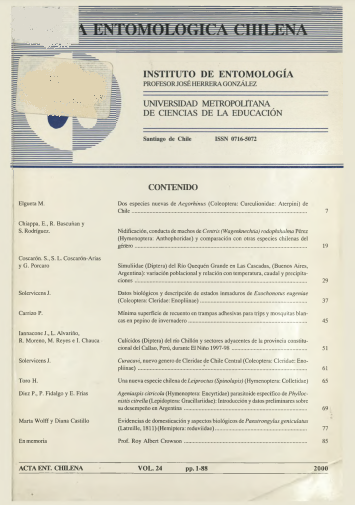Contenido principal del artículo
jul 7, 2022
Resumen
The present study evaluated somc areas of natural breeding places of mosquitoes near human populations
in Callao-Perú during December 97 to August 98: Chillón River margins, adjacent areas to underdevelopment
town “Los Carrizales” and Ventanilla wetlands (Ventanilla district) and underdevelopment towns: Tiwinza,
Daniel A. Carrión and Francisco Bolognesi (Carmen de la Legua district), Larvae of culicids of medical
importance as Anopheles pseudopunctipennis (Theobald), Culex quinquefasciatus (Say) and Aedes
taeniorhynchus(Wiedemann) were assessed. A. taeniorhynchus was registered for the first time during August
98 at “Los Carrizales” and Ventanilla wetlands in areas with the highcst salinities (39,5%) in comparison
with the other areas of natural breeding places of mosquitoes. The least water temperatures (21,1 °C) and the
highest pH (7,8) were observed in these localities. Chillón River presenled the highest richness of biological
taxa of all localities evaluated. The culicid A. pseudopunctipennis was observed in Chillón River at the
highest air lemperature (28,6 °C) and water temperature (28,1 °C) and the least pH (7,02). Moreover, spatial
and temporal variation of population and the larvae índex were observed in nine survey points of Chillón
River. High larvae indexes of A. pseudopunctipennis were associated with presence of the algae Cladophora
glomerata (L.) Kuelzing and with the macrophyte Lemna minor (L.). The larvivorous fish Poecilia reticulata
Pelers, nayads of Libellulidae and Coenagrionidae (Odonata) and adults of Dyliscidae (Coleóptera) were
recorded as potential prcdators. The results were compared with those of the 1995-96 Pre-ENSO event,
concluding that one of the consequences of Southern Oscillation ENSO “El Niño” 1997-98 event in the
Peruvian coast was an increase of the population of these culicids of medical importance.


